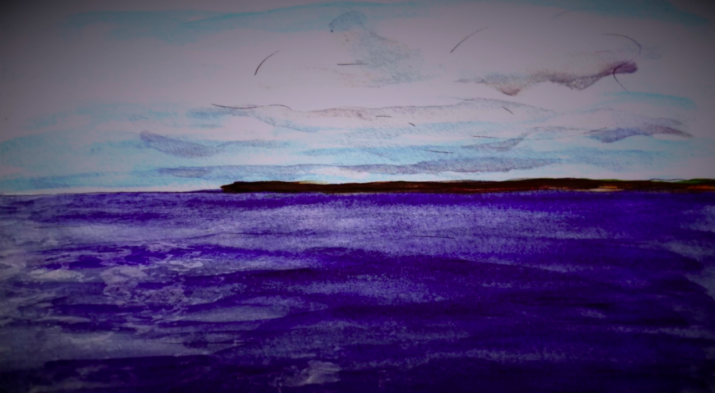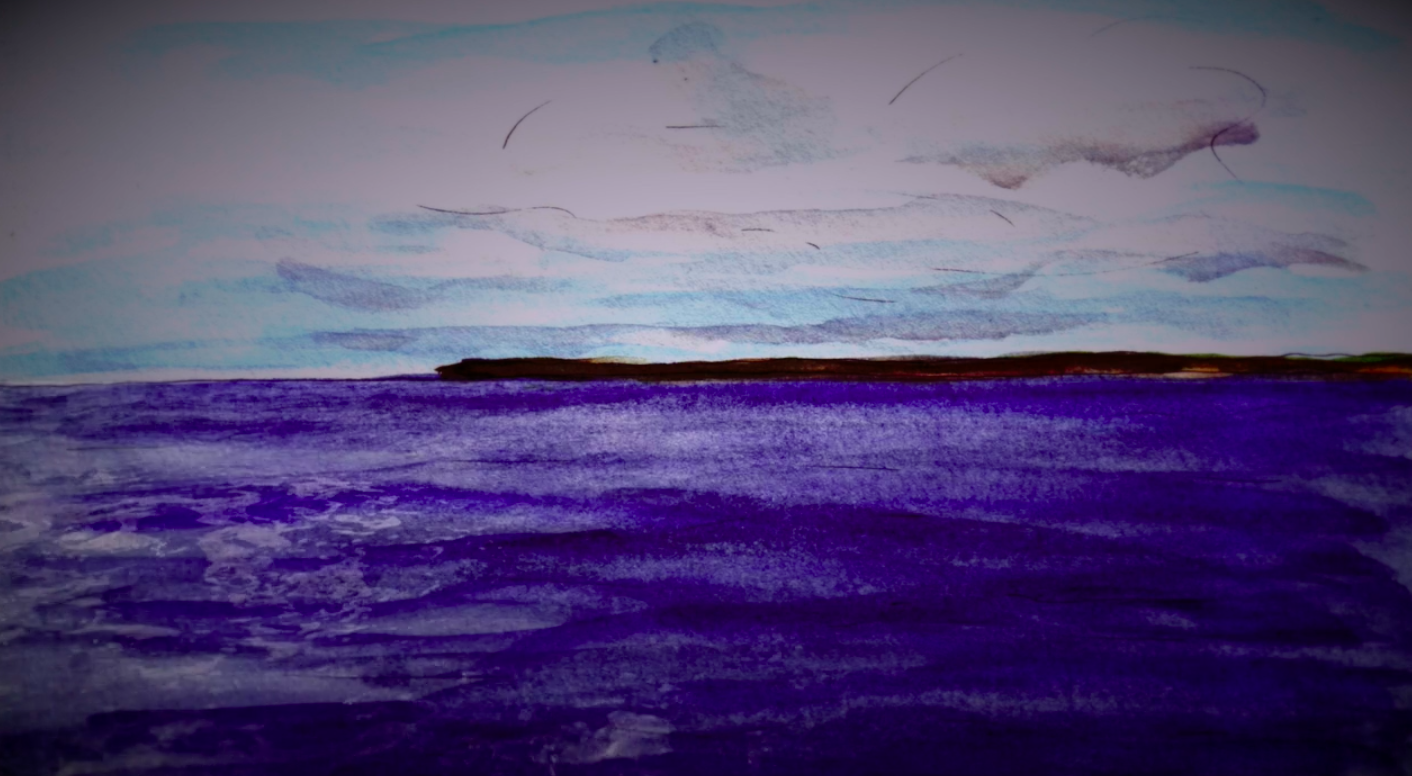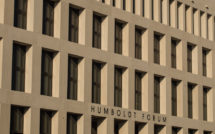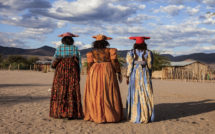

This is part of our special feature, European Art, Culture, and Politics.
When the corpse of the Salvadorian child, Valeria, and her father, Óscar Alberto Martínez Ramírez circulated in the media after they drowned attempting to cross the Rio Grande on June 24, 2019, it’s inevitably the image of three-year old Syrian refugee,[1] Alan Kurdi, lying dead on the beach in Bodrum, Turkey, on September 2, 2015 that comes to mind. These images joined a myriad of photographs representing the plight of refugees from the Global South attempting to make their way to the Global North. The individualization of the refugee crisis through images of the dead draws attention to their plight, but also raises questions about the growing reliance on corpses to do the political work necessary to create humanitarian responses.[2] It seems that the dead refugees have more currency as objects (not subjects) of moral reflection in liberal discourses of humanitarianism, than the living. Here, I examine the relationship between the actual forensic and legal treatment of “refugee dead” washing up on the shores of the Mediterranean Sea and their evolution from material evidence of structural violence to artefacts of cultural meaning. The remains of refugee dead carry not just evidentiary weight as subjects of systemic violence, but also symbolic value as a measure of the ability of cultures to mourn not only their own dead, but also those of “foreigners.”
The treatment of the dead across cultures can lead to transcultural efforts to recognize vulnerable human beings as “grievable,” even as divergences in belief systems vary widely.[3] This responsibility for the dead emerges, in my opinion, from Dominik La Capra’s notion of the “empathic unsettlement” of the secondary witness to violence or Emmanuel Levinas’ insistence on empathy as the non-identification with the other.[4] Rather than express empathy as a gesture to take the other into one’s own ontological sphere, this form of empathy recognizes the sovereignty of the other (dead or alive) to exist in their own right. Just as the living have rights, so do the dead. How does the representation of the refugee dead elide the value of the living and of their agency?
Images of overcrowded boats have become iconic for the plight of refugees. At the same time, however, the portrayal of the overcrowding elicits a sense of the pitiful and helpless victims, masses, in need of saving from the humanitarians of the global north. Conversely, the iconic image of Alan Kurdi and the incorporation of the image into hundreds of renditions appropriated by groups to promote a wide range of ideological causes, represents one example of how an image of a corpse takes on an afterlife that conveys grievability on the one hand, while, on the other, raising concerns about the manipulation of images. As laudable as it might appear to document the refugee dead, what are the ethical consequences of placing a higher value on the visual depiction of the refugee dead to garner donations and sympathy, when the living remain mired in the morass created by the Global North? Similarly, Judith Butler argues that the grievability of bodies is directly tied to their status within hegemonic systems of power that relegate some human beings to a category of lessor or no rights, and others to an elevated status of individuality and of value.[5] Drawing on this notion, I explore how the literal and figurative representation of refugee afterlives in cultural production stands in stark contrast to the juridical and bureaucratic logic to which refugees are subjected when alive.
Data collected by the International Organization of Migrants’ (IOM) Missing Migrants Project indicates that approximately 18,500 refugees have perished due to drowning in the Mediterranean Sea between 2014 and 2019, a substantial number of the total 27,000 recorded since 1993.[6] Many refugees die before they are accounted for and even as the names of the dead remain grossly incomplete, the named victims take on new lives as mediated subjects. That is, the bodies of refugees, migrants, and asylum seekers become legible as the sites of contention for defining citizenship, sovereignty, and power. The embodied experience of many refugees who are subject to inhuman treatment, classification, and exclusion, shifts in death. Their remains take on meaning and value that transforms their ungrievability while alive to a sanctioned grievability when dead.
Creating grievable subjects by naming the victims is one of the major concerns of the forensic scientists engaged in recovering the dead. International human rights law recognizes the right of the dead not just in armed conflict, but also in so-called peace to a proper burial.[7] Forensic scientists engaged in identifying the refugee dead along the coast of southern Europe are working in a state of limbo, attempting to do their work, yet knowing that the state of the bodies will not permit their preservation with dignity. The well-known forensic scientist, Cristina Cattaneo (Italy) and her colleagues have argued that:
[t]he need to identify the dead – an issue of paramount importance for the forensic sciences – and its importance for humanitarian, administrative, judicial and other purposes are universal values enshrined by domestic and international law. However, for hundreds of men, women and children, migrants, who die every year in their attempt to cross the Mediterranean Sea to reach Europe this fundamental right remains unfulfilled.[8]
Cattaneo wishes to assure that the dead receive a proper and dignified memorial and/or burial. This assumes, however, that the remains can be identified and that there are sufficient means to perform this act. In reality, only about 22.1 percent of the corpses washing up on the shores of Italy, for example have been identified.[9] These “unknown dead” join the ranks of countless others in the wake of forced disappearances and displacements. Given the lack of funds and the sheer number of bodies to process, and the high cost of the forensic tools and lack of existing DNA material for matching the corpses with individual databases, the work of processing the corpse is often left to local volunteers and non-governmental organizations. Whereas many of the forensic techniques employed to process the migrant remains grew out of the work of forensic anthropologists and others at the site of mass graves in the aftermath of genocide, war, and forced disappearance, the particular condition of the refugee bodies makes them more difficult to identify. Not only are many of the refugees without any form of identification, they also come from situations in which their families would be in danger should they come forward to provide DNA material. Consequently, artists, filmmakers, and other cultural workers have sought other means to represent the refugee dead to make them visible. How do those who employ artistic means to provide a surrogate proper burial represent the corpses of the dead, figuratively, and, indeed, in some cases, literally?
Rather than displace the corpses of the refugees into artistic imaginaries, the Berlin-based political activist art group, The Center for Political Beauty, incorporated the remains of dead refugees into a spectacle labeled “The Dead are Coming.”[10] They combined the commemorative gestures and forensic methods outlined above with political activism to draw attention to the plight of the refugees. The group initiated the actual burial of a thirty-four-year-old Syrian woman, the mother of four children, who drowned in the Mediterranean while attempting to make her way to Berlin. The Center, with the permission of her family, exhumed her body where it had been buried unceremoniously in Sicily, and brought it to Berlin for a Muslim burial ceremony conducted by an imam in the Gatow cemetery. Rather than see corpses relegated to storage facilities and mass graves, the Center’s tactic framed acts of proper burial as spectacles and employed digital means of dissemination, even as the they enacted the burial in reality. They hoped that “we will listen to the dead seeing as we ignored their screams while they were still alive.”[11]
The action was meant to draw attention to the plight of the living refugees by exposing the irony that it was easier for dead refugees to get to Berlin than living refugees. As the Berliner Zeitung put it: “In light of the fact that the victims did not make it to our country alive, the Center for Political Beauty brings us their bodies…the intervention transforms piles of corpses into individuals who lost their lives. It transforms refugees into people.” The same commentator referenced the figure of Antigone, implying that the contemporary plight of dead refugees is one with mythic connotations. [12]
Nevertheless, there is something unsettling about performing the act of exhuming and reburying a corpse as an act of resistance. The Center’s approach raises ethical issues about how the dead are transformed into political capital through aesthetic means. The actual materiality of the dead became the basis for its virtual afterlife. What realms of privacy are violated here? The spectacle claims to raise awareness among those who have the means to protect the living refugees and to save them. But what is wrong with this picture? Beyond the squeamishness associated with using a corpse for spectacle, regardless of the permission of the family, what of the grievability of the body? The Center’s intention was to employ the remains in order to establish the humanness of the millions of refugees who remain unnamed, undocumented, and unseen.
The remains became a means to an ulterior motive: to transform refugees into a realm of visibility and to acknowledge their rights as human beings. Even as the relocation of the dead to the center of Europe questions the stability of borders, themselves constructed spaces, one wonders about the limits of a proper burial performed as a political act. One would need to acknowledge the actual danger imposed upon the families of refugees who attempt to retrieve the remains of their dead or who are unable to reach out for fear of their own deportation. Indeed, the Syrian woman’s family did not attend the funeral given their precarious legal status. As one of the Center’s activists, Tilda Rosenfeld put it: “Unfortunately, one cannot bring the dead back to life…. However, as we bring them to the heart of Europe, their final resting place will be our political unrest. An unrest that will make Europe a continent of migration again.”[13]
Also meant to evoke a feeling of unrest, Christoph Büchel’s installation Barco Nostra displayed at the 2019 Venice Biennale consists of the salvaged hull of a large fishing vessel that sank in the Mediterranean while carrying hundreds of refugees during its attempt to reach Italy from Libya on April 18, 2015. Close to eight-hundred of the refugees drowned or remain missing. The transformation of the fishing vessel from an object under forensic investigation to an aesthetic artifact of memory was meant to be “a relic of human tragedy, but also a monument to contemporary migration.”[14]Salvaging the boat, when most of the corpses could not be recovered, stands as a troubling reminder of the displacement of the dead into the ship that carried them to their death. In response, the critic Yasmin Alibhai-Brown pointed out that the installation “lacked integrity” because “Büchel simply used the dispossessed on the high seas to flaunt his artistic and political nihilism.”[15] Meant to commemorate the dead, the ship became an aesthetic artifact, devoid of the remnants of the dead. Like other exhibitions that incorporate the objects of the dead into their wake, viewers were left to imagine the ship full of refugees, an authentic object of commemoration, yet detached from the human agency that perpetuated the deaths.
The dead are similarly absent in Charles Heller’s and Lorenzo Pezzani’s Left-to-Die project. This technologically savvy investigation documented the trajectory of a migrant (their designation) boat from March 27, 2011 to its sinking on April 10, 2011 that left all but 11 of the original 72 passengers dead. The researchers reconstruct the conditions that transformed the sea into a “deadly liquid.” Devoid of images of the dead or their names, this project documented the fraught journey of the boat to exemplify the prevalence of neglect that also precipitated the death of the passengers. The project emphasizes the context in which the deaths came to pass, using a combination of data collected from SAR satellite imagery, weather reports, NATO and Italian coast guard maritime communications, vessel-tracking technologies and survivor testimonies.[16] Demonstrating that distress calls from the boat had been recorded nine times without a response as dictated by maritime international law, this project draws attention to the structural violence that perpetuates the looking away from the plight of the refugees and migrants.
Like the two previous works, the poetic response to refugee dead, the film ASMAT: Names in Memory of all Victims of the Sea (2015) directed by a former refugee, Dagmawi Yimer focuses on the relationship of the refugee dead to water. In both cases, the sea doubles as a potential passage to a better life and safety and as a treacherous, deadly entity. The film commemorates the refugee dead, more visible dead than alive, many of Eritrean origin, who perished on October 3, 2013 after drifting for two days on the Mediterranean Sea. The ship caught on fire and sank when the passengers, desperate to be seen from Lampedusa less than a mile away, lit a blanket, which then turned the boat into an inferno, creating a panic that led to the boat capsizing. Of the total number of passengers on board, close to 110 were confirmed dead, close to 250 remained missing, and 150 survived. The filmmaker hopes to “count them all, name each and every one to make us aware of how many names lost their bodies on one single day, in the Mediterranean Sea.”[17] The film portrays refugee remains as grievable through symbolic representations that counter the governance of the dead under nation state and international humanitarian law. Yimer’s film thus “commemorates life by actualizing its absence.”[18]
Reminiscent of Christine Sharpe’s metaphorical incantation of the multiple meanings of the wake to conjure the memory of the intentional killing by drowning of slaves during the Middle Passage, the images of the hull of the boat creating a wake in the film, also conjure up the ritual of laying the dead to rest as in the funeral wake.[19] In the film, the dead appear through varying forms of media, included animated water colors and actual human figures draped in white veils as they wade through what we assume to be ocean water. Their figures create small wakes and the film itself creates a dirge through the female voice-over whose eulogy for the dead doubles as an indictment of the oppressive and harmful policies of neglect, outright persecution, and exclusion at the root of the displacement of migrants and refugees. The voice begins to recite the names of the dead who were killed when the boat capsized and the names of the passengers in the Eritrean native language, Tigrinya, rise out of the ocean into view. The names, such as hope, peace, and beauty, emerge and represent the now absent future lives of those who drowned, particularly the children. Like the Ancient Mariner in Coleridge’s poem, the narrator beseeches viewers not to turn away.
As the growing body of art, performance, and political interventions by living refugees and their supporters shows, commemorating the dead does not necessarily require the display of the deceased bodies. Rather, memorializing refugee dead through “forensic imagination” allows their implied presence to expose a neo-liberal agenda of concern that relegates living refugees to a lesser value than refugee dead. Not without flaws, each example here demonstrates that the refugee dead have afterlives that circulate as surrogate forms of (im)proper burial. What remains, however, are increasing number of refugees who continue to be invisible in life.
Karen Remmler is the Mary Lyon Professor of Humanities at Mount Holyoke College. Her current book project The Afterlives of the Dead in the Wake of Mass Violence focuses on the transformation of human remains from evidentiary material to symbolic subjects of proper burial. Recent publications focus on the representation of the dead in the digital age and comparative genocide studies. Karen is an Edith Birnbaum Milman Memorial Fellow at the Jack, Joseph and Morton Mandel Center, United States Holocaust Memorial Museum.
References:
[1]The terminology governing the distinctions between “refugee” and “migrant” is vexed to say the least. The term “refugee” has been codified by international law, whereas the term “migrant” remains broad and legally unclear. See IOM UN Migration, accessed January 20, 2020, https://www.iom.int/migration. For the purpose of this essay, I have chosen to employ the term refugee throughout in order to draw attention to the need to expand the legal designation of “refugee” to include people whose displacement is precipitated not only by direct acts of political violence, but also structural violence in the wake of climate change, economic degradation, withholding of aid and proxy wars. Hannah Levinson provides a helpful expansion of the UNHCR 1951 definition in her essay “Refocusing the Refugee Regime: From Vagrancy to Value,” Res Cogitans (2010) 1:143-155, 143, accessed January 20, 2020, 143, https://commons.pacificu.edu/rescogitans/vol1/iss1/18/ .
[2] See: Time. 100 Photos, accessed January 20, 2020, http://100photos.time.com/photos/nilufer-demir-alan-kurdi, and Azam Ahmed and Kirk Semple, “Photo of Drowned Migrants Captures Pathos of Those Who Risk It All.” NYTimes, June 25, 2019, accessed January 20, 2020, https://www.nytimes.com/2019/06/25/us/father-daughter-border-drowning-picture-mexico.html.
[3] See, Judith Butler, Frames of War: When Is Life Grievable? (New York: Verso, 2009). See also: Monika Mokre, “How Do Lives Become Grievable? On the short summer of migration and the time after,” Refugee Outreach & Research Network (9/5/2016) accessed February 14, 2020 http://www.ror-n.org/-blog/how-do-lives-become-grievable-on-the-short-summer-of-migration-and-the-time-after
[4]Dominick LaCapra, Writing History, Writing Trauma (Baltimore: John Hopkins UP, 2013). Emmanuel Levinas, Time and the Other, trans. Richard A. Cohen (Pittsburgh: Duquesne University Press, 1987).
[5] Butler, Frames of War: When is Life Grievable?
[6] Missing Migrants, accessed January 20, 2020, https://missingmigrants.iom.int/. See also Niamh McIntyre and Mark Rice-Oxley, “Its 34,361 and Rising: how the List tallies Europe’s migrant body count, Guardian June 20, 2018, accessed January 20, 2020, https://www.theguardian.com/world/2018/jun/20/the-list-europe-migrant-bodycount. See also R. Simon. “Analysis of Best Practices on the Identification of Missing Migrants: Implications for the Central Mediterranean.” Central Mediterranean Route Thematic Report Series. International Organization for Migration, Geneva, 2019, accessed Feb. 9, 2020. https://publications.iom.int/system/files/pdf/identification_of_missing_migrants.pdf
[7] accessed Feb. 9, 2020 https://ihl-databases.icrc.org/customary-ihl/eng/docs/v1_rul_rule113
[8] Cristina Cattaneo, M. Binz Tidball, L. Penados, J. Prieto, O. Finegan, M. Grandi, “The Forgotten Tragedy of unidentified Dead in the Mediterranean,” Forensic Science International, 250 (May 2015), e1. https://doi.org/10.1016/j.forsciint.2015.02.007 See also Barbie Latza Nadeau. “Giving Dead Migrants a Name” Scientific American. (August 9, 2017). https://www.scientificamerican.com/article/giving-dead-migrants-a-name/ (accessed Jan 20 2020).
[9] R. Simon, “Analysis of Best Practices on the Identification of Missing Migrants: Implications for the Central Mediterranean.” Central Mediterranean Route Thematic Report Series. International Organization for Migration, Geneva (2019) 11, accessed February 9, 2020. https://publications.iom.int/system/files/pdf/identification_of_missing_migrants.pdf.
[10] https://politicalbeauty.com/dead.html accessed May 1, 2019.
[11] “The Dead are Coming,” accessed February 9, 2020, https://politicalbeauty.com/dead.html.
[12] Ibid.
[13] Henri Neuendorf, “Controversial German Art Collective Buries Deceased Migrants in Berlin” Art World, June 18, 2015, accessed January 20, 2020,
https://news.artnet.com/art-world/art-collective-bury-dead-migrants-berlin-308975.
[14] Elisabetta Povoledo, “Wreck of Migrant Ship that Killed Hundreds Will Be Displayed at the Venice Biennale, NYTimes May 6, 2019, accessed February 11, 2020, https://www.nytimes.com/2019/05/06/arts/design/migrant-boat-venice-biennale-christian-buchel.html
[15] Quoted in BBC News, “Venice Biennale: Is exhibiting tragic migrant ship distasteful?” May 15 2019, accessed January 20, 2020, https://inews.co.uk/opinion/venice-biennale-migrant-boat-christoph-buchel-morality-502089.
[16] “The Left-To-Die-Boat,” accessed February 9, 2020, https://forensic-architecture.org/investigation/the-left-to-die-boat.
[17] Dagmawi Yimer, “ASMAT-Names in memory of all victims of the sea” accessed January 20, 2020, https://vimeo.com/114343040.
[18] Simona Wright, “A Politics of the Body as Body Politics: Rethinking Europe’s Worksites of Democracy,” in Gabriele Proglio and Laura Odasso, Border Lampedusa: Subjectivity, Visibility and Memory in Stories of Sea and Land (London: Palgrave, 2018) 91.
[19] Christine Sharpe, In the Wake: On Blackness and Being, (Durham: Duke UP, 2016).
Photo: A still from ASMAT: Names in Memory of all Victims of the Sea
Published on April 28, 2020.




